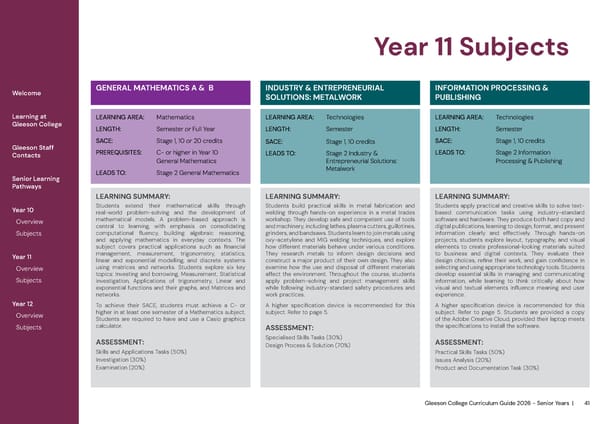Gleeson College Curriculum Guide 2026 - Senior Years | 41 Year 11 Subjects Welcome Learning at Gleeson College Gleeson Staff Contacts Senior Learning Pathways Year 10 Overview Subjects Year 11 Overview Subjects Year 12 Overview Subjects LEARNING SUMMARY: Students extend their mathematical skills through real-world problem-solving and the development of mathematical models. A problem-based approach is central to learning, with emphasis on consolidating computational fluency, building algebraic reasoning, and applying mathematics in everyday contexts. The subject covers practical applications such as financial management, measurement, trigonometry, statistics, linear and exponential modelling, and discrete systems using matrices and networks. Students explore six key topics: Investing and borrowing, Measurement, Statistical investigation, Applications of trigonometry, Linear and exponential functions and their graphs, and Matrices and networks. To achieve their SACE, students must achieve a C- or higher in at least one semester of a Mathematics subject. Students are required to have and use a Casio graphics calculator. ASSESSMENT: Skills and Applications Tasks (50%) Investigation (30%) Examination (20%) GENERAL MATHEMATICS A & B LEARNING AREA: Mathematics LENGTH: Semester or Full Year SACE: Stage 1, 10 or 20 credits PREREQUISITES: C- or higher in Year 10 General Mathematics LEADS TO: Stage 2 General Mathematics INDUSTRY & ENTREPRENEURIAL SOLUTIONS: METALWORK LEARNING AREA: Technologies LENGTH: Semester SACE: Stage 1, 10 credits LEADS TO: Stage 2 Industry & Entrepreneurial Solutions: Metalwork LEARNING SUMMARY: Students build practical skills in metal fabrication and welding through hands-on experience in a metal trades workshop. They develop safe and competent use of tools and machinery, including lathes, plasma cutters, guillotines, grinders, and bandsaws. Students learn to join metals using oxy-acetylene and MIG welding techniques, and explore how different materials behave under various conditions. They research metals to inform design decisions and construct a major product of their own design. They also examine how the use and disposal of different materials affect the environment. Throughout the course, students apply problem-solving and project management skills while following industry-standard safety procedures and work practices. A higher specification device is recommended for this subject. Refer to page 5. ASSESSMENT: Specialised Skills Tasks (30%) Design Process & Solution (70%) INFORMATION PROCESSING & PUBLISHING LEARNING AREA: Technologies LENGTH: Semester SACE: Stage 1, 10 credits LEADS TO: Stage 2 Information Processing & Publishing LEARNING SUMMARY: Students apply practical and creative skills to solve text- based communication tasks using industry-standard software and hardware. They produce both hard copy and digital publications, learning to design, format, and present information clearly and effectively. Through hands-on projects, students explore layout, typography, and visual elements to create professional-looking materials suited to business and digital contexts. They evaluate their design choices, refine their work, and gain confidence in selecting and using appropriate technology tools. Students develop essential skills in managing and communicating information, while learning to think critically about how visual and textual elements influence meaning and user experience. A higher specification device is recommended for this subject. Refer to page 5. Students are provided a copy of the Adobe Creative Cloud, provided their laptop meets the specifications to install the software. ASSESSMENT: Practical Skills Tasks (50%) Issues Analysis (20%) Product and Documentation Task (30%)
 2026 Gleeson College Senior Years Curriculum Guide 2026 Page 40 Page 42
2026 Gleeson College Senior Years Curriculum Guide 2026 Page 40 Page 42